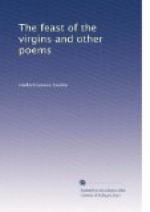[55] Mille Lacs. This lake was discovered by Du Luth, and by him named Lac Buade in honor of Governor Frontenac of Canada, whose family name was Buade. The Dakota name for it is Mde Wakan—Spirit Lake.
[56] The Ojibways imitate the hoot of the owl and the howl of the wolf to perfection, and often use these cries as signals to each other in war and the chase.
[57] The Dakotas called the Ojibways the “Snakes of the Forest” on account of their lying in ambush for their enemies.
[58] Strawberries.
[59] See-yo—The prairie-hen.
[60] Mahgah—The wild-goose. Fox-pups. I could never see the propriety of calling the young of foxes kits or kittens, which mean little cats. The fox belongs to the canis or dog family, and not the felis or cat family. If it is proper to call the young of dogs and wolves pups, it is equally proper to so call the young of foxes.
[61] When a Dakota is sick he thinks the spirit of an enemy or some animal has entered into his body, and the principal business of the “medicine-man”—Wicasta Wakan—is to cast out the “unclean spirit,” with incantations and charms. See Neill’s Hist. Minn., pp. 66-8. The Jews entertained a similar belief in the days of Jesus of Nazareth.
[62] Wah-zee-yah’s star—The North-star. See note 3.
[63] The Dakotas, like our forefathers and all other barbarians, believe in witches and witchcraft.
[64] The Medo is a wild potato; it resembles the sweet-potato in top and taste. It grows in bottom-lands, and is much prized by the Dakotas for food. The “Dakota Friend,” for December, 1850. (Minn. Hist. Col.)
[65] The meteor—Wakan-denda—Sacred fire.
[66] Me-ta-win—My bride.
[68] The Via Lactea or Milky Way. The Dakotas call it Wanagee Tach-anku—The pathway of the spirits; and believe that over this path the spirits of the dead pass to the Spirit-land. See Riggs’ Tah-koo Wah-kan, p. 101.
[69] Oonk-tay-he. There are many Unktehees, children of the Great Unktehee, who created the earth and man, and who formerly dwelt in a vast cavern under the Falls of St. Anthony. The Unktehee sometimes reveals himself in the form of a huge buffalo-bull. From him proceed invisible influences. The Great Unktehee created the earth. “Assembling in grand conclave all the aquatic tribes he ordered them to bring up dirt from beneath the waters, and proclaimed death to the disobedient. The beaver and otter forfeited their lives. At last the muskrat went beneath the waters, and, after a long time, appeared at the surface, nearly exhausted, with some dirt. From this Unktehee fashioned the earth into a large circular plain. The earth being finished he took a deity, one of his own offspring,




